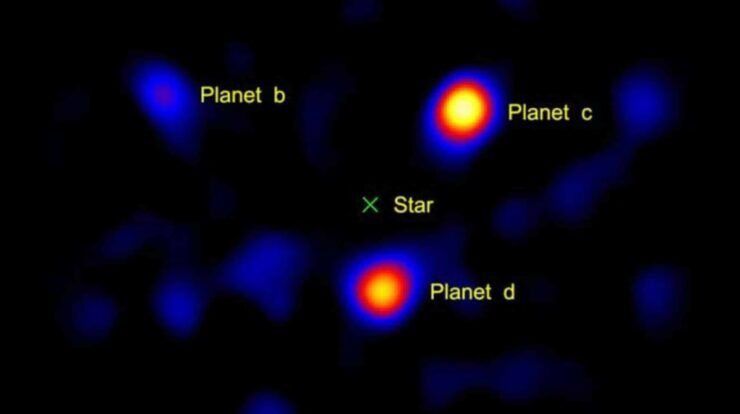
A breathtaking new video compresses more than a decade of deep-space observation into a few seconds, revealing the hypnotic motion of distant worlds. The animation, created by astrophysicist
Jason Wang
from
Northwestern University
features four large exoplanets circling the youthful star HR 8799.
A Giant Step Forward in Depicting Extraterrestrial Planets
Published by
Space.com
, the video is based on observations gathered over 12 years using the
W. M. Keck Observatory
In Hawaii, we are monitoring the movement of celestial bodies beyond our solar system.
solar system
It is not an easy task. The four
exoplanets
orbiting
HR 8799
are huge—with each one being bigger than
Jupiter
—yet they are extremely far away, situated roughly
133 light-years
away in the
Pegasus constellation
.
Using advanced
adaptive optics
and a
coronagraph
, researchers were able to block out the intense glare of the parent star, allowing the reflected light of these distant “firefly” planets to emerge in a visible pattern. These tools were critical for making the video possible and showcasing the orbits in a way that human eyes could appreciate.
The recently launched animation expands on an earlier edition that covered just seven years. By incorporating an additional five years of information, the orbital paths have become noticeably smoother, providing a refined view of these large celestial objects performing a gradual celestial minuet around their Sun-like star.
Why Is HR 8799 So Unique?
HR 8799
it is not merely an ordinary star. With a mass 1.5 times that of our Sun,
five times more luminous
, it’s both massive and young. With an estimated age of just
30 million years
, it’s a cosmic infant compared to our
4.5-billion-year-old Sun
.
Its youth is one of the reasons scientists were able to detect and study its planets. Young gas giants like those around
HR 8799
are still hot and glowing from the heat of their formation, making them much easier to spot in infrared light. That’s why HR 8799 was the
first star system ever to have its exoplanets directly imaged
, a landmark achieved in
2008
.
The system includes at least four planets—each more massive than
Jupiter
—with orbital periods that range from
45 years
for the closest planet to a staggering
500 years
for the farthest.
These are real images of exoplanets. Four super-Jupiters, imaged 10 times over 12 years around a star 133 lightyears away.
by
u/Neaterntal
in
spaceporn
Why The Timelapse Matters
Although the animation doesn’t provide fresh scientific data, it serves a crucial function in
science communication
As Jason Wang states, “Scientifically, there’s nothing to gain from viewing orbital systems through a time-lapse video, yet it aids others in appreciating our research.”
“It can be challenging to convey the intricacies of science through words alone. However, demonstrating science in practice aids others in grasping its significance,” he noted.
Visualizing something that takes centuries to unfold in real time helps bridge the gap between abstract astrophysical data and human understanding. It translates highly complex orbital mechanics into an intuitive, almost poetic, experience. For researchers, it’s also a powerful educational tool.
The Long Game Of Planet Hunting
Studying
exoplanetary systems
like HR 8799 is a slow and patient process. Scientists rely on decades of data to confirm orbital paths, planetary masses, and interactions between celestial bodies.
Unlike short-term missions or satellite flybys, observing planets in orbit requires
long-term commitment
, often over the span of
multiple scientific careers
. In this case, 12 years of data were compressed into a 4-second clip, representing the persistent work of astronomers tracking objects moving at unimaginable scales.
It’s a reminder that space science is not only about spectacular rockets and fast-paced discoveries. Much of the discipline lies in the quiet accumulation of data,
pixel by pixel
, night after night.
Enjoyed this article?
Subscribe to our free newsletter
For captivating tales, special material, and up-to-date information.
To read more stories like this, check out
Dailyexe
.





